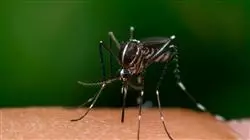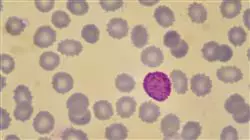University certificate
The world's largest faculty of nursing”
Introduction to the Program
The promotion of tourism has facilitated the arrival of imported diseases to all parts of the world, making it necessary for nursing professionals to specialize in order to improve patient care"

The management of infectious pathologies in Emergency Departments is becoming increasingly complex, due to the appearance of new diseases or imported diseases that are not frequent in certain countries, but also because of the resistance that many infections are acquiring to the drugs used to cure them.
Globalization, mass tourism and the possibility of reaching places that until a few years ago were almost impossible to imagine have caused diseases that were confined to certain countries to cross their own borders. As a result, it is now possible to diagnose patients with rare infections or infections that until recently did not even exist in certain regions. These developments in the healthcare field make it necessary that nurses should also increase their training and knowledge in this type of pathology, as they are the first professionals to deal with these patients. Therefore, this Postgraduate Diploma will deal in depth with the main diseases that affect both residents who travel to exotic places and immigrants who move to other places, focusing on tropical diseases such as malaria.
On the other hand, being a 100% online training, the professional will have the ability to decide when and from where to study, without commitments or obligations, thus being able to combine their study time with the rest of their daily obligations.
Expand your knowledge in the field of imported diseases and achieve greater benefits in the care of your patients"
This Postgraduate diploma in Imported Infectious Diseases in the Emergency Department for Nursing contains the most complete and up-to-date scientific program on the market. The most outstanding features of this program are:
- The development of clinical cases presented by experts in Imported Infectious Diseases in the Emergency Department
- The graphic, schematic, and eminently practical contents with which they are created provide scientific and practical information on the disciplines that are essential for professional
- Therapeutic developments on intervention in imported infectious diseases
- Practical exercises where to carry out the self-assessment process to improve learning
- An algorithm-based interactive learning system for decision-making in the clinical situations presented throughout the course
- Its special emphasis on research methodologies
- Theoretical lessons, questions to the expert, debate forums on controversial topics, and individual reflection assignments
- Content that is accessible from any fixed or portable device with an Internet connection
With this high-level program you will be able to explain the epidemiology of tropical infectious diseases in travelers, immigrants and VFR"
It includes, in its teaching staff, professionals belonging to the field of nursing, who bring to this training the experience of their work, in addition to recognized specialists from leading scientific societies.
The multimedia content, developed with the latest educational technology, will provide the professional with situated and contextual learning, i.e., a simulated environment that will provide an immersive training experience designed to train for real-life situations.
The design of this program is based on Problem-Based Learning, through which the nurse must try to solve the different professional practice situations that arise throughout the academic course. For this purpose, the professional will be assisted by an innovative interactive video system developed by recognized experts in the field of imported infectious diseases with extensive teaching experience.
You will study in depth each of the areas in which professionals must be trained to be able to practice with knowledge in the care of infectious pathologies"

We provide you with the best teaching methodology of the moment so that you can train as if you were facing real cases"
Why study at TECH?
TECH is the world’s largest online university. With an impressive catalog of more than 14,000 university programs available in 11 languages, it is positioned as a leader in employability, with a 99% job placement rate. In addition, it relies on an enormous faculty of more than 6,000 professors of the highest international renown.

Study at the world's largest online university and guarantee your professional success. The future starts at TECH”
The world’s best online university according to FORBES
The prestigious Forbes magazine, specialized in business and finance, has highlighted TECH as “the world's best online university” This is what they have recently stated in an article in their digital edition in which they echo the success story of this institution, “thanks to the academic offer it provides, the selection of its teaching staff, and an innovative learning method aimed at educating the professionals of the future”
A revolutionary study method, a cutting-edge faculty and a practical focus: the key to TECH's success.
The most complete study plans on the university scene
TECH offers the most complete study plans on the university scene, with syllabuses that cover fundamental concepts and, at the same time, the main scientific advances in their specific scientific areas. In addition, these programs are continuously being updated to guarantee students the academic vanguard and the most in-demand professional skills. In this way, the university's qualifications provide its graduates with a significant advantage to propel their careers to success.
TECH offers the most comprehensive and intensive study plans on the current university scene.
A world-class teaching staff
TECH's teaching staff is made up of more than 6,000 professors with the highest international recognition. Professors, researchers and top executives of multinational companies, including Isaiah Covington, performance coach of the Boston Celtics; Magda Romanska, principal investigator at Harvard MetaLAB; Ignacio Wistumba, chairman of the department of translational molecular pathology at MD Anderson Cancer Center; and D.W. Pine, creative director of TIME magazine, among others.
Internationally renowned experts, specialized in different branches of Health, Technology, Communication and Business, form part of the TECH faculty.
A unique learning method
TECH is the first university to use Relearning in all its programs. It is the best online learning methodology, accredited with international teaching quality certifications, provided by prestigious educational agencies. In addition, this disruptive educational model is complemented with the “Case Method”, thereby setting up a unique online teaching strategy. Innovative teaching resources are also implemented, including detailed videos, infographics and interactive summaries.
TECH combines Relearning and the Case Method in all its university programs to guarantee excellent theoretical and practical learning, studying whenever and wherever you want.
The world's largest online university
TECH is the world’s largest online university. We are the largest educational institution, with the best and widest online educational catalog, one hundred percent online and covering the vast majority of areas of knowledge. We offer a large selection of our own degrees and accredited online undergraduate and postgraduate degrees. In total, more than 14,000 university degrees, in eleven different languages, make us the largest educational largest in the world.
TECH has the world's most extensive catalog of academic and official programs, available in more than 11 languages.
Google Premier Partner
The American technology giant has awarded TECH the Google Google Premier Partner badge. This award, which is only available to 3% of the world's companies, highlights the efficient, flexible and tailored experience that this university provides to students. The recognition as a Google Premier Partner not only accredits the maximum rigor, performance and investment in TECH's digital infrastructures, but also places this university as one of the world's leading technology companies.
Google has positioned TECH in the top 3% of the world's most important technology companies by awarding it its Google Premier Partner badge.
The official online university of the NBA
TECH is the official online university of the NBA. Thanks to our agreement with the biggest league in basketball, we offer our students exclusive university programs, as well as a wide variety of educational resources focused on the business of the league and other areas of the sports industry. Each program is made up of a uniquely designed syllabus and features exceptional guest hosts: professionals with a distinguished sports background who will offer their expertise on the most relevant topics.
TECH has been selected by the NBA, the world's top basketball league, as its official online university.
The top-rated university by its students
Students have positioned TECH as the world's top-rated university on the main review websites, with a highest rating of 4.9 out of 5, obtained from more than 1,000 reviews. These results consolidate TECH as the benchmark university institution at an international level, reflecting the excellence and positive impact of its educational model.” reflecting the excellence and positive impact of its educational model.”
TECH is the world’s top-rated university by its students.
Leaders in employability
TECH has managed to become the leading university in employability. 99% of its students obtain jobs in the academic field they have studied, within one year of completing any of the university's programs. A similar number achieve immediate career enhancement. All this thanks to a study methodology that bases its effectiveness on the acquisition of practical skills, which are absolutely necessary for professional development.
99% of TECH graduates find a job within a year of completing their studies.
Postgraduate Diploma in Imported Infectious Diseases in the Nursing Emergency Department
The Postgraduate Diploma in Imported Infectious Diseases in the Emergency Department for Nursing is a specialization that focuses on developing the skills and competencies necessary for Nursing professionals to deal with the most common infectious diseases in the hospital setting. With the increase in globalization, the movement of people from different parts of the world and the rise of tourism, it is increasingly common to encounter imported infectious diseases. That is why this academic training is essential for Nursing professionals to be ready to treat and prevent these diseases within the emergency department. The Postgraduate Diploma in Imported Infectious Diseases in the Emergency Department for Nursing at TECH offers a complete and updated program of studies on the most frequent diseases that can be acquired through contact with patients from different parts of the world. With this program the student will have the opportunity to acquire all the necessary knowledge to prevent, detect and effectively treat cases of infectious diseases. Among the skills developed in this academic program are the early identification of infectious diseases, the proper management of patients, the implementation of preventive measures and the use of techniques and tools to detect and treat infectious diseases in a safe and appropriate manner.
Study 100% online
The specialization is taught 100% online by TECH, which means that thousands of people around the world can participate at any time just by having internet access. In addition, this Postgraduate Diploma has the participation of experts in different areas of medicine and Nursing, which ensures quality teaching and constant updating of knowledge. In summary, the Postgraduate Diploma in Imported Infectious Diseases in the Emergency Department for Nursing is a necessary preparation for Nursing professionals who wish to be prepared for any eventuality and be able to offer a quality and safe service to all their patients in the emergency department.







